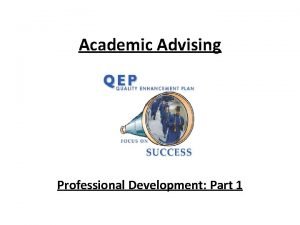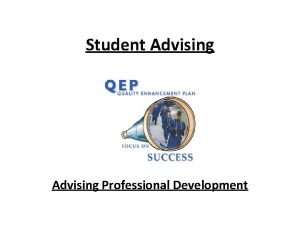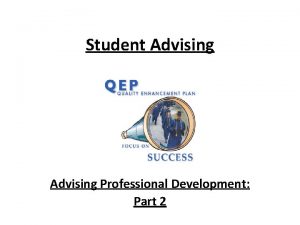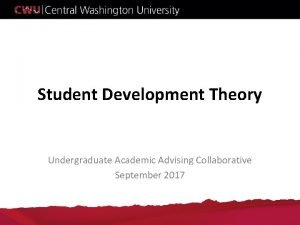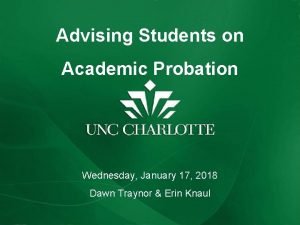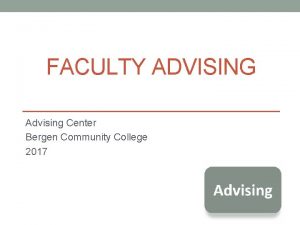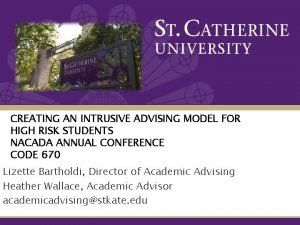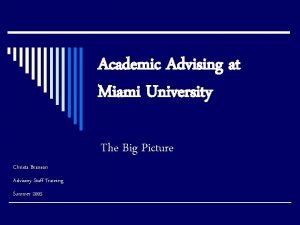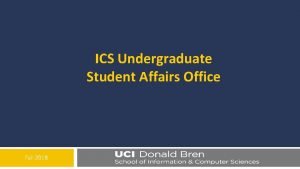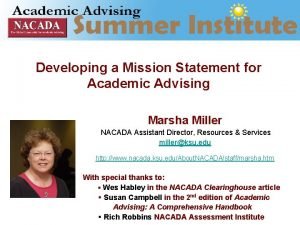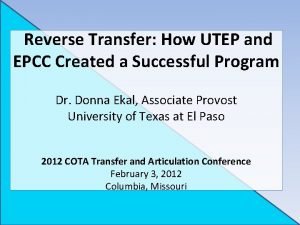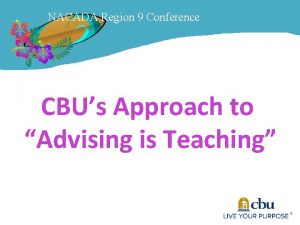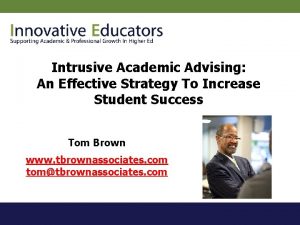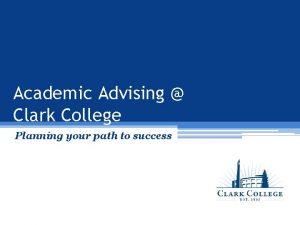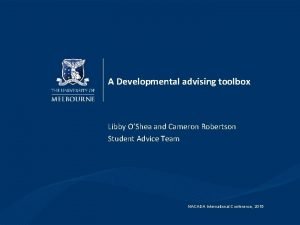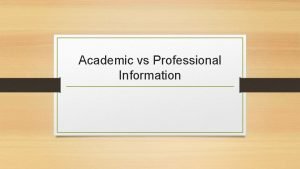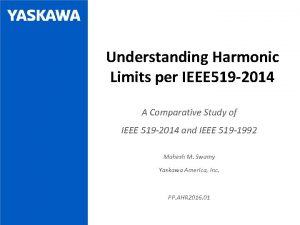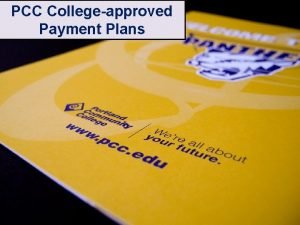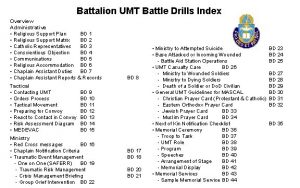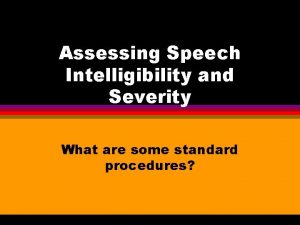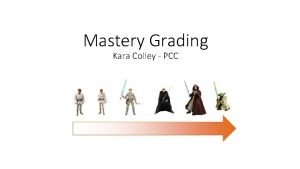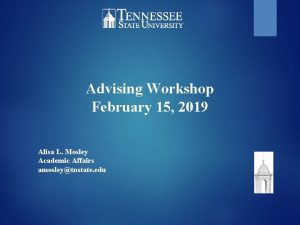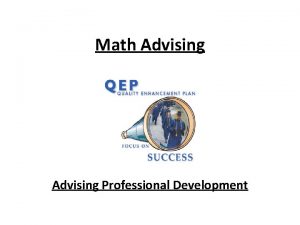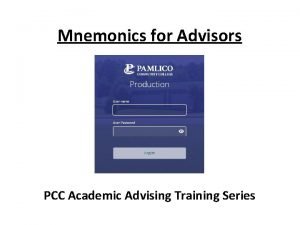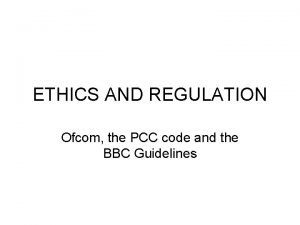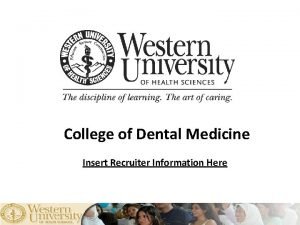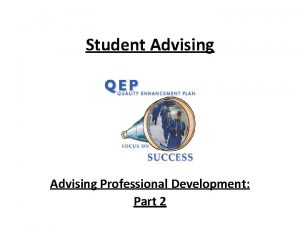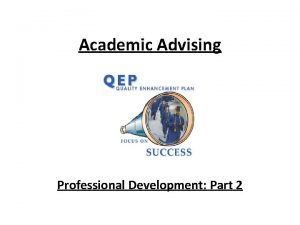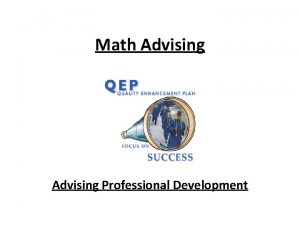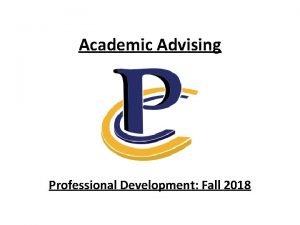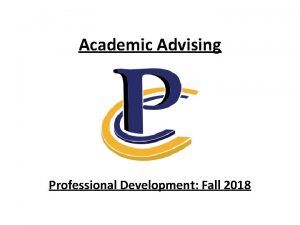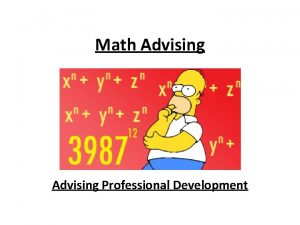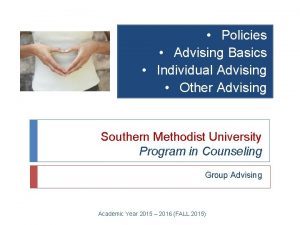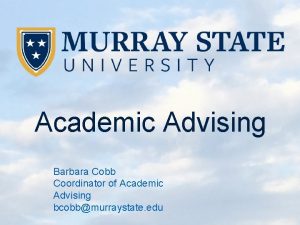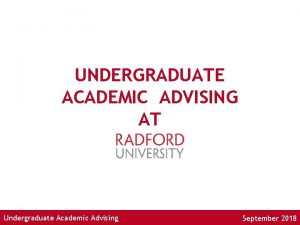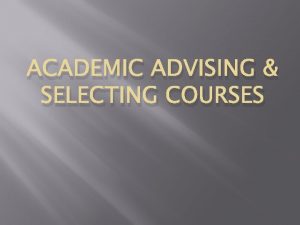Academic Advising Professional Development Part 1 PCC Academic






















































- Slides: 54

Academic Advising Professional Development: Part 1

PCC Academic Advising Center • Look under My Courses: – Scroll down to Resources and you’ll find it there.

Student Advising Guidelines • First semester academic performance: – Performance during the first semester is the best predictor of retention. – Knowing this, we should place students in the proper courses in order to maximize their potential for success.

• Evidence shows that effective academic advising and uncomplicated registration procedures can be major factors in student retention. • Through positive interaction with students, college bonds and connections can be formed, making both advising and registration core processes in retention.

Getting Started

Getting Started • Upon meeting a new student for the first time, introduce yourself and your program. Engage in conversation; learn as much as you can about them as a person. • Talk to the student about why they are here at PCC. – Ask about the student’s educational and career goals and help him/her develop an educational plan to reach those goals.

– Ask questions such as: Are you planning to transfer to a four-year college? Are you planning to go to work after you receive your two-year degree? If so, what are you planning to do? These kinds of questions will help determine which classes within the program of study best suit the student. – Based on the conversation, you need to determine if they in the right place. If they are interested in another program, introduce them to the proper subject matter expert.

• As you get to know the student, be sure to start a file on them for your records. • Collect basic information as listed at the top of the FOS Advising Checklist. – Pay careful attention to contact numbers. This makes getting up with the student in the future much easier. – Give the student your contact information as well.

• Before you go much further, ask the student if they have taken care of the following things: – Have you filled out a PCC application? If not, refer the student to the PCC website. – Have you filled out financial aid paperwork, if applicable? If not, have the student go to Student Services and speak with someone in the Financial Aid Department.

– Check their math and English placement test scores. Look in Datatel under “TSUM”. If they have not taken these tests, have them go to the PCC library front desk to set up a time to take them. – Have you taken college courses elsewhere? If so, have you had an official transcript sent to the college registrar?

Student Information • Before you register a student for classes, – Go over their “PSPR” on the Datatel Colleague System. – Check to see if the program advisor listed is correct. – Make sure the student’s Program of Study is correct.

– Look over the courses to make sure the student has been given credit for all the courses they have taken toward graduation requirements. – Check to see if the academic catalog year listed is correct or the best it can be given the student’s situation. • After you look over the student’s “PSPR”, go into the student’s “STAC” and make sure everything looks good compared to the “PSPR”.

Course Selection

Course Selection • For new and returning students, suggest basic courses that will help start their educational pathway in a successful manner. For example: – ACA 111 or 122 – English (based on test score) – Math (based on test score) – CIS 110 – One subject matter (core course) course.

• Explain to the student the importance of enrolling in ACA 111 (College Student Success) or ACA 122 (College Transfer Success) during their first semester enrolled. – These courses need to be HIGHLY suggested as one of the first courses they take in order to better assure their academic success.

– ACA 111 should be suggested if the students’ intent is to only complete a two-year degree. – ACA 122 should be suggested if the students’ intent is to pursue a four-year degree. • Encourage student to enroll in their math and English courses during their first semester. – Taking composition courses prior to reading intensive courses (literature, history, etc. ) or courses with significant research papers (Psychology, etc. ) will help increase academic success in other courses.

– Courses that require the ability to make precise calculations are better taken after math course work has begun. • Encourage student to enroll in CIS 110 (Introduction to Computers), if needed, during their first semester. – Skills learned in these courses are useful in all other courses. • Online courses: Online courses have a certain level of difficulty and are not suggested to be the bulk of a first year students’ first semester schedule.

• First year students need to be registered for seated classes whenever possible. – They will be more successfully during that first semester if you do this. – A partial internet course (PI), is a good way to give them a taste of what an online course is like with the benefit of seeing the instructor each week. • First year students typically do not realize the work and discipline it takes to be successful in the online environment.

• The same could be said of a current student with a history of poor performance in online courses. – You may want to advise against taking online courses when possible. – The more seated versions they take, the better they will probably do. – Until they develop the discipline needed for online coursework, this is the best practice. – This is something you will learn as you get to know your students. – Check Aviso notes for information that can help you determine a history of difficulty.

• Explain to the student when and how courses are offered here at PCC. – Certain courses are offered on a rotational basis (only during the spring or fall semester). – Certain courses are offered every semester (English and math courses, for example). – Some courses have pre-requisites that must be met before you can take them.

• In this case, you must be mindful of the rotation of those courses. • For example, EDU 144 (fall) leads to EDU 145 (spring) which leads to EDU 221 (fall). – Some courses are only offered in certain formats (online or seated, for example. )

• Question the student about other commitments and factors (work, family, Internet access for online courses, etc. ) to help you determine the number of credit hours and course difficulty for that particular student. Ask questions such as: – Do you work? What days? What hours? – Are you responsible for your family? – Do you have military obligations?

– Do you plan to be part-time or full-time? – Can you attend day classes? Evening classes? – Do you plan to take distance education courses (online)? • Many of your students are working adults with job schedules that do not always fit the course offerings for seated-tradition courses. – In these instances, online courses are a great learning alternative.

– However, some students do not fully understand the steep learning curve that can come with online courses. • As students register for online courses for the first time, be sure to explain the following to your students: – Online courses are convenient but by no means are they easier than seated-traditional course offerings.

– Time management may be the biggest factor in succeeding in online courses. Successful online students have to be very proactive in their studies and take responsibility for their own learning. – Online students need to have a certain level of “computer know-how. ” If they do not have this knowledge, it is suggested they complete CIS 110 before attempting an online course. – Online students need to have reliable access to the internet and the proper computer equipment to participate in the course.

– Procrastinating in an online course, or any course, is not recommended. Deadlines come quick and life happens. By planning ahead, you can avoid all the problems procrastination may bring. • Guide the student in choosing classes that will meet the degree requirements. – Do not encourage students to take courses not listed in the program of study UNLESS they plan to pay for them out-of-pocket. Financial aid will not pay for such courses. – Remind them that such courses do not count toward their degree and graduation.

• Together with the student, select courses that: – Satisfy program requirements. – Logically lead to faster degree completion. – Are offered in a format that best suits the student’s ability. – Are offered during times the student is available.

• As you and the student go through this process, teach them how to use the program of study checklist and other forms to plan class schedules and how to track their own progress toward graduation requirements. – Give the student a copy of their program of study checklist, a copy of their Datatel Colleague program evaluation using (PSPR), and the PCC Academic Plan by Semester Form. Explain how to use each.

– Armed with such information, students can now come to future advising sessions prepared with their tentative class schedule. – As an academic advisor, you should strongly suggest that students prepare for advising sessions in this manner. – A student knowledgeable of their program of study tends to be more success than one who is not. – This also empowers the student to have more ownership of their college career.

• As you advise the student, if they choose to ignore the advice given to them: – Document how you advised the student on the FOS Advising Checklist Form. – Have the student sign the form acknowledging that they have chosen to disregard your advice as to the best way to complete their degree program. – This statement is located on the back of the form. This form is located on the PCC Academic Advising Center.

Advising For Math • Programs at PCC require different math courses to fulfill the degree math requirement. • In order to help the student fulfill their educational goals, talk to them about their plans. – Do you only desire a 2 year degree or do you plan to pursue a 4 year degree or higher at some point?

– This question is important because it will help you advise the student which math course would best meet their educational goals. – For example, if an EDU student only wants the 2 year degree, I advise them to take either MAT 110 or 143. If they plan to pursue a higher degree, I advise them to take MAT 171.

• Math and college transfer: – MAT 110 is not transferable to a four year college/university. – MAT 143 & 152 are transferable, but some university programs do not prefer it. MAT 152 is typically more transferable than MAT 143. – MAT 171 is transferable and preferred by many more university programs than MAT 143 & 152. • When dealing with a transfer student, check with each individual College/University program to find out more about which transferable community college math they prefer.

Courses Not In The Program of Study • Academic advisors should not place students in courses that are not part of the program of study in order to “give them hours. ” – These courses will not be paid for by financial aid. – Be prepared for the occasional student who will ask you to do this.

• If a student wishes to take a course that is not a part of their program of study for personal enrichment, you must explain the following things: – The course will not be paid for by financial aid. – The course will not count toward graduation requirements. • Be sure to fill out the PCC Course Acknowledgement Form in this instance. – Located on the PCC Advising Moodle site.

Phantom Courses • Typical Phantom courses: ACA 111 OL, ACA 122 OL, & CIS 110 OL – The students do not know that these sections are available. – They are in the system, but will not be published in copies of the Fall schedule that are available to the general public.

• Why? To help first year students be more successful in these important introductory courses. These students need to be enrolled in as many face-to-face courses as possible during their first two semesters. – The data shows that these students do not do as well in the online versions of the three courses targeted. – For example, 20% (7 of 25) of Fall 2014 FOS online students were successful (C or better), compared to 50% (6 of 12) of face-to-face first year students.

• As you know, give any student the choice between a seated, PI, or online section, many will choose the online. • Some students (especially first year students) often do not realize the level of work required to be successful in an online course.

• For this experiment to work, advisors should not mention the existence of these sections until they have exhausted all scheduling options with the student. – Of course, some students cannot take on-campus courses (EDT students from across the state or country, for example). No need to play the game with them, unless they are locals (Craven/Pamlico area).

Phantom Course Registration Procedure • In order to register a student for one of these phantom online courses, you must receive prior approval. – Email Neil Callahan: ncallahan@pamlicocc. edu

• Be sure to include the student’s name, desired phantom course, and ID number. – Neil will forward your email to Tammy Spain or Julie Simpson and they will register the student for the course.

The Semester Begins

Making Changes • The following changes must be made before the 10% point. – Academic catalog of record – Course substitutions – Program of Study • To start these processes, use the proper forms posted on the PCC Academic Advising Center. • Failure to do so can lead to negative results for students.

Web. Advisor • When your courses begin, as students enter the course (seated or online), please be sure to put an “E” under the date of entry in Web. Advisor. – Do so before the 10% point. Do not wait. • If the 10% point has passed and a student has not entered the course, go to Student Services and drop them from the course ASAP.

Census Reports • All fully online course require students to complete an enrollment verification assignment. – This assignment serves as a way for the student to “enter” the online course. • The census report document must be printed once all students have “entered” the course. – This document serves as proof the student entered the course.

– This document must be turned into the college registrar. – Note: I would wait till the day after the census date (the last day to enter the course) to print this document unless everyone has completed the assignment.

Dropping Students (Instructor-Initiated) • To drop a student from your course, you must go to Student Services and fill out a Drop/Add form. – Be prepared to list a last day of attendance for the student (unless they never entered the course).

• Do not wait too long to drop a student who has: – Not been attending class. – Not been turning in assignments (whether online or face-to-face courses). – Never entered the course (whether online or faceto-face courses).

• If you have questions and are not sure if it’s time to drop the student, go to Student Services and talk with someone. – Together you can decide if you have a situation in which a student needs to be dropped. • If the drop is completed before the drop deadline, the student receives no grade (W). – This has no effect on their GPA.

• If not, if they are dropped after the drop deadline, the student will receive a grade of “WF”. – It counts as an F and effects the student’s GPA. – The “WF” is a way for Student Services to see that the student has stopped participating in the course as opposed to just not performing well enough to pass (F). • Be sure to include the last date of attendance on the drop form.

Early Alerts • If you have a student in academic trouble and have exhausted all your means to contact them about the matter, be sure to access Aviso and enter an Early Alert. – Your Early Alert will be received by someone in Student Services.

PCC Academic Advising Center • Look under My Courses: – Scroll down to Resources and you’ll find it there.

PCC Virtual Transfer Center • Look under My Courses: – Scroll down to Resources and you’ll find it there.

Questions?
 Pcc academic advising
Pcc academic advising Pcc advising
Pcc advising Moodle pcc
Moodle pcc Pcc advising
Pcc advising Student development theory academic advising
Student development theory academic advising Pcc academic probation
Pcc academic probation Bergen community college advising
Bergen community college advising Intrusive advising model
Intrusive advising model Miami university academic advising
Miami university academic advising College of liberal arts and sciences uf advising
College of liberal arts and sciences uf advising Ics undergraduate student affairs
Ics undergraduate student affairs Pillars of academic advising
Pillars of academic advising Uwb biology degree checklist
Uwb biology degree checklist Lane community college academic advising
Lane community college academic advising Fau university advising services
Fau university advising services Dilbert mission statement generator
Dilbert mission statement generator Uwb advisor appointment
Uwb advisor appointment Epcc transfer credits to utep
Epcc transfer credits to utep Nacada region 9 conference
Nacada region 9 conference Intrusive advising
Intrusive advising Wku academic advising
Wku academic advising Clark college advising
Clark college advising Academic advising unimelb
Academic advising unimelb Academic vs professional
Academic vs professional Ieee 519 1992
Ieee 519 1992 Pcc payment plan
Pcc payment plan Pcc moodle
Pcc moodle Pcc chemistry
Pcc chemistry Pcc market membership
Pcc market membership Pcc/pci checklist army
Pcc/pci checklist army Pcc severity rating scale
Pcc severity rating scale Diol oxidation
Diol oxidation Pcc grading scale
Pcc grading scale Primary alcohol examples
Primary alcohol examples Primary alcohol pcc
Primary alcohol pcc Engelova krivka
Engelova krivka Contoh soal kurva pcc
Contoh soal kurva pcc Pcc dss
Pcc dss Mike mosley pcc
Mike mosley pcc Pcc tuition appeal
Pcc tuition appeal Elasticita substituce
Elasticita substituce Math placement
Math placement Pcc structure
Pcc structure Pcc mnemonic
Pcc mnemonic Engelova krivka
Engelova krivka Pcc code of conduct
Pcc code of conduct Sony pcc
Sony pcc Westernu pcc
Westernu pcc Uri pcc
Uri pcc Ra 10912 known as
Ra 10912 known as 7 norms of collaboration
7 norms of collaboration Ecetp.pdp.albany.edu.elearning
Ecetp.pdp.albany.edu.elearning Learning and development plan for teachers
Learning and development plan for teachers Compare sources of information on professional development
Compare sources of information on professional development Professional development norms
Professional development norms
